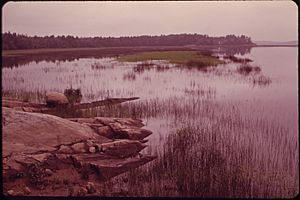Merrymeeting Bay facts for kids
Merrymeeting Bay is a special kind of freshwater bay in Maine, a state in the United States. It's not like a typical ocean bay. Instead, it's more like a large river delta that gets tides, even though its water is mostly fresh. Scientists call it an "inland delta" or "tidal riverine" because of its unique mix of river and tidal features.
The bay starts near Swan Island. Several towns and cities are located around it, including Bath, Brunswick, Topsham, Bowdoinham, Dresden, and Woolwich. You can usually reach the bay from public docks on the rivers that flow into it.
Contents
What Makes Merrymeeting Bay Unique?

Six rivers flow into Merrymeeting Bay. The two biggest are the Kennebec River and the Androscoggin River. The four smaller rivers are the Cathance, Eastern, Abagadasset, and Muddy rivers. This means the bay collects water from nearly 40% of Maine's land area, plus some from New Hampshire. That's a huge area, almost 20,000 square miles (51,800 km²)!
Merrymeeting Bay connects to the Atlantic Ocean through the Lower Kennebec River. This long channel is where the river meets the sea. Together, the bay and the Lower Kennebec River are known as the Kennebec Estuary.
The Chops: A Narrow Gateway
The bay connects to the Lower Kennebec River through a very narrow spot called The Chops. This opening is only about 280 yards (256 meters) wide. Water flows quickly through The Chops, which can be tricky for boats.
At low tide, water from the bay rushes out through The Chops. At high tide, a mix of fresh river water and some seawater comes back up the Kennebec. However, the large amount of fresh water from the six rivers usually pushes out more than the ocean tide brings in. This, combined with the narrow Chops, means the bay has very little salt, making it mostly fresh water with some tidal influence.
The bay is about 17 miles (27 km) from the Atlantic Ocean. The tides here average about 5 feet (1.5 meters). This special mix of fresh water and strong tides creates a unique habitat. It's an intertidal area, meaning the water level changes with the tides, and it's home to many rare plant species.
Animals and Plants of Merrymeeting Bay
Merrymeeting Bay is a very important place for wildlife. It's especially known for its large numbers of migrating birds.
Birdlife in the Bay
Many birds use Merrymeeting Bay as a resting stop during their long journeys. For the eastern coast of the United States, the number of waterfowl (like ducks and geese) found here is second only to Chesapeake Bay. The bay is also home to many bald eagles, which are majestic birds of prey.
The strong tidal currents and a bit of salt in the Lower Kennebec River keep the water below The Chops from freezing. This makes it a perfect place for waterfowl to spend the winter. However, the freshwater in the bay and the Kennebec River above The Chops freeze completely.
Fish and Other Aquatic Life
Merrymeeting Bay is also a vital place for many types of migratory fish. These fish travel between freshwater and saltwater. Some of the important species here include the endangered Atlantic salmon and shortnose sturgeon. Other fish found here are Atlantic sturgeon, shad, alewives, and American eel.
The History of Merrymeeting Bay
The exact origin of the name "Merrymeeting Bay" is not completely clear.
Name Origins
Some people think the name comes from a term in the Abenaki language. The Abenaki people had seasonal camps near the bay. However, their names for the bay, like Chisapeak ("at the big part of the river") and Quabacook ("duck watering place"), don't mean "merry meeting."
The English name might come from old festive gatherings called "merry meetings" that were popular in colonial times. These were like traditional spring fairs in England, where people played games and danced. Early English colonists might have used this name to describe the bay.
Local Leaders and Fur Trade
In the 17th century, a local Abenaki leader named Chief Rawandagon, who was the headman (sagamore) of the lower Kennebec area, was sometimes called "Robin Hood" by the English. He was said to lead a group of "merry men," similar to the folk tales. There was even a place called Robinhood Cove nearby, named after this chief.
Historian Frank Burroughs suggests the name might also be linked to annual spring meetings of fur traders and trappers. These gatherings were times for trading goods. He also thinks the name might have been used to attract certain English colonists and keep away others, like the strict Puritans, because the bay was a place where rum was brought in. Early English names for the bay also included New Somerset Lake and Swan Pond.
See also
 In Spanish: Bahía Merrymeeting para niños
In Spanish: Bahía Merrymeeting para niños


